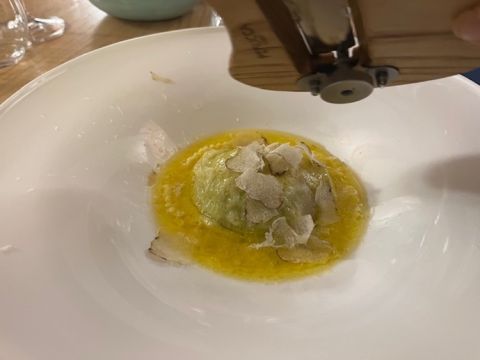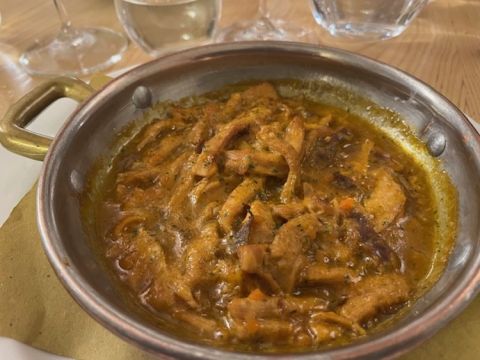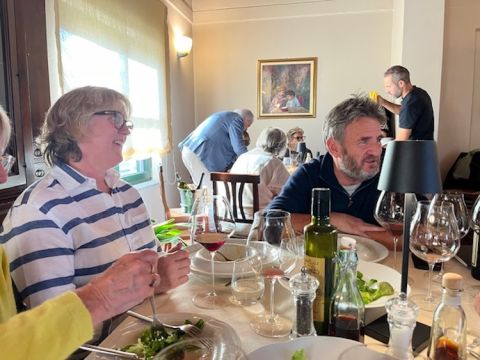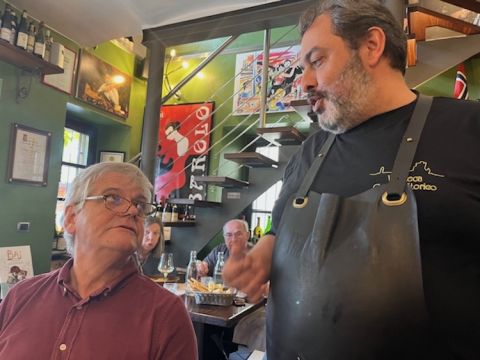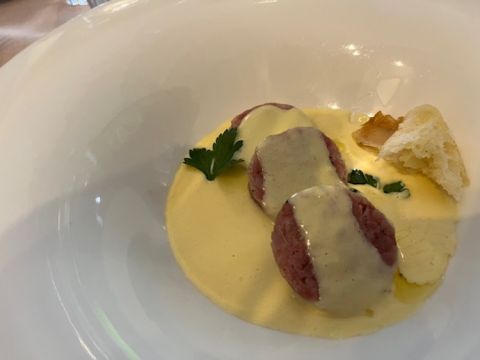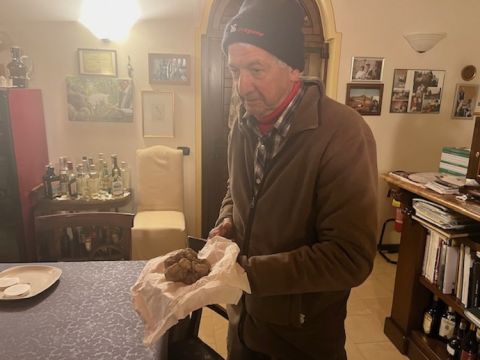Eating in the Langhe
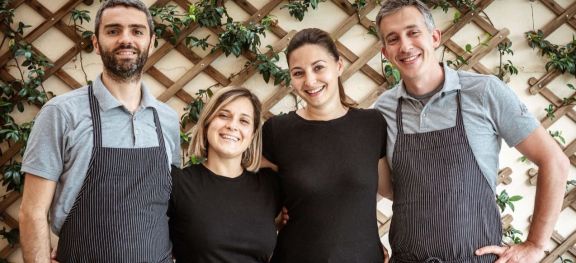
The hills of Barolo and Barbaresco are always welcoming, but never more so than in white-truffle season. See also Still eating in the Langhe.
One of the most challenging consequences of climate change for every vine grower and food producer worldwide is its unpredictability.
When we visited the vineyards of Tuscany in early June (see Glorious Sangiovese), we were struck by the verdancy of the countryside. Little did anybody realise the consequences of all this rain for that region’s olive oil crop.
As Beatrice Contini Bonacossi of Capezzana in Carmignano explains, ‘We had a really nice flowering in April and a nice crop that looked promising. Then it rained heavily in May and June, followed by a very dry summer with a sudden rainstorm and hail on 26 July. It was hot in August and September. We started to pick olives on 16 October and then a rainstorm hit on 2 November when almost all the olives on our 30,000 trees fell down. Fortunately, the quality wasn’t affected. It was a really challenging year for the grapes, too.’
About 280 kilometres (170 miles) to the north-west, the spring rains have had a more positive effect, as we noted on opening the front door of L’Osteria Veglio, an enchanting restaurant in the Barolo commune of La Morra. We were immediately assailed by the unique, heady aroma of white truffles.
Thanks to the heat of summer 2023, this year’s truffle season started late, but by mid November it was in full flow. A couple of heavy rainstorms had softened the earth, which yielded a very successful crop, the first in three years. According to one of the two women who with their husbands run this restaurant, this is the first year that they have been able to buy white truffles with confidence in quality and a certain amount of quantity. This has allowed them to purchase a dozen of these white beauties, which they have cleaned up and placed on a round, wooden tray under a glass cloche, and left on a sideboard, next to a grater, for all the room to enjoy.
This is a restaurant run with consummate efficiency. The dining room belongs to the two women, who seem to know their customers very well, while the kitchen is the province of their husbands who double as smiling waiters when their food is ready to serve. The quartet – Massimo and Cristina Corso and Katharina and Emanuel Marengo (Cristina and Emanuel being sister and brother) – are, left to right, pictured above this article.
The menu is divided into antipasti, first courses (mainly pasta) and main courses. Their wine list is as discursive and as generously priced as in all the other restaurants we visited. The prices will come as a very pleasant surprise to any visitor from London, Paris or New York. In London we have become inured to main courses that start at the £35/£40 mark; here the main courses range from €16–€18 with dishes incorporating the precious white truffles of Alba at around €40.
We decided to eat and drink as though we were locals. We began with a bottle of appetising Barbera d’Alba – Brovia’s Sori’ del Drago 2021. Roberto Conterno of Giacomo Conterno once told David Gleave MW, ‘You can tell which are the tables of people from outside Piemonte because they are drinking Barolo. We locals drink Barbera.’
I was taken with a dish of a raviolone, the single raviolo pictured above filled with spinach, ricotta and soft egg yolk, topped with butter and white truffles (€50). I was told to slice it and mix everything together. What resulted was a lovely mixture of comforting pasta, soft egg yolk and the crunch of the first of this year’s truffles. I followed this with another local dish, veal tripe, and ended with another local speciality: a warm hazelnut cake with vanilla sauce and black cherries (both are pictured below). (In this area, hazelnut trees cover the flat ground, fodder for the Ferrero Rocher company headquartered in nearby Alba, while vines cover the slopes.) For excellent food and two bottles of very respectable Barolo, I paid a bill of €620 for the five of us and vowed to return.
L’Osteria Veglio is small, as are all the other restaurants we visited, and seats no more than about 40 at well-spaced tables. Tourism is increasingly popular in Piemonte, particularly at this time of the year, leading to changes both welcome and unwelcome to those who live in the region. Our tables had been booked well in advance; do follow suit.
It was over lunch at Antica Torre in the heart of Barbaresco, in the shadow of the town’s ancient tower, a few hundred metres from the Gaja HQ and across from the offices of the equally excellent Produttori del Barbaresco, that I heard for the very first time the word ‘truffle-age’.
We had just been seated in the sunny upstairs in this seemingly unchanged restaurant when a table of six elderly but obviously well-off lunchers took their seats next to us. One of the party reached into his bag and brought out a plastic container, unwrapped the contents and put on his side plate two white truffles. These, as shown in the picture above, he proceeded to grate over all of the dishes his table enjoyed: veal tartare followed by the house speciality tajarin (a particularly fine tagliatielle), plus another of polenta topped with an egg yolk. It was this that prompted me to ask our charming waitress for their truffle equivalent of corkage – truffleage? – policy. She smiled and whispered, ‘They’re regulars.’
We began with a couple of plates of mixed antipasti which included some very fine veal tartare (described as carne cruda battuta on Piemontese menus), vitello tonnato and Russian salad, another local speciality and a much finer version of this much-traduced dish than any other I have tasted. I followed this with a special of the day, veal tongue with salsa verde. The meat was two thick, succulent slices topped with a sauce that was definitely green but also had a sharpness to cut through. The five of us compared a Barbaresco Montestefano 2019 from Serafino Rivella with another 2019 Barbaresco, Albesani Santo Stefano from Castello di Neive. We finished with slices of chestnut cake and hazelnut cake, the latter being made even more delicious with the addition of a bright yellow zabaglione custard. I licked my spoon as clean as a whistle.
While these two restaurants are the results of a combination of team effort, history (both are located in old houses) and excellent cooking, Vinoteca Centro Storico, a wine shop and associated small restaurant in the heart of Serralunga, is very much about its host, Alessio Cighetti, and his wife Stefania Saglietti, who does the cooking.
Cighetti, seen above with David Gleave MW, is a big man who only just manages to navigate the stairs to the upper floor with a bottle of wine in one hand and several glasses in the other. Clearly popular with and respected by the locals, he wears an apron, sports a beard and holds out his paw of a hand by way of a greeting.
The ground-floor dining room reveals his passions: champagne, which seems to be a necessity of life in this region; cheese of all descriptions in a humidity-controlled transparent box; and, next to these, three legs of different hams waiting to be sliced.
We marvelled at the long list of champagnes and after some discussion we settled on a bottle from a producer new to us (though not Julia, who tasted a couple of his wines thanks to UK importer Uncharted Wines), Stéphane Regnault. His Lydien No 80 Grand Cru Blanc de Blancs from Oger, with a dosage of just 1 g/l, seemed to stimulate all of us.
We ate equally well. I began with a dish of cotechino on a bed of fonduta, the runny, hot melted local cheese (€13) that had the desired effect of settling my stomach after the morning’s wine tasting. I followed this with a dish of rolata di coniglio, rolled rabbit (€20), the meat tender but overshadowed by the quality of the roast potatoes which accompanied it. With this we enjoyed a bottle of Pio Cesare’s 2017 Barolo Mosconi before a much-needed espresso and a bill of €453 for the five of us.
Cighetti shares the three essential ingredients for any successful restaurateur anywhere: a love of food, of wine, and of his customers. But he has surrounded himself with two extra opportunities to shine. Here every available inch of space on the walls is covered in either wine-related posters or holds a plethora of empty wine bottles. And the music will appeal to anyone who recalls the 1970s and 1980s. Creedence Clearwater Revival was playing as we walked in. By the time we left it was the turn of the Doobie Brothers.
The unpredictability of the changing weather was referred to by at least two of the winemakers on our itinerary. The first commented that when, as a result of rain, they can pick porcini mushrooms in August, then they know the vintage will be difficult, as 2023 has proved to be. But the rain in 2023 was not enough to bring to an end two years of drought. As Franco Massolino commented from his tasting room with views across to the Alps to the north, ‘This winter, we definitely need snow.’
In praise of white truffles
Being in Piemonte during the white-truffle season, I could not go home without one in my suitcase – particularly as I am the chef with one significant dinner less than a week away.
Unfortunately, we were not in Alba where there is a truffle market. What to do? The answer was remarkably simple: ask our tour leader and fixer David Gleave MW. He kindly made a few phone calls and told me that we could meet a truffle hunter at 6 pm in the trattoria Tra Arte e Querce in the little hamlet of Monchiero Alto to which, having stopped at a cash machine, we headed.
The truffle hunter is pictured above, against the light. In his 70s, he is up every morning at 4.30 am during the season with his dog. He is lean and generous. He immediately went downstairs and brought up a box of white truffles whose aroma filled the room. He put this down on a table and next to it he placed a set of weighing scales.
He asked me how many I would like to feed and he took out two. His advice was simple: to keep them in the fridge, take them out of the fridge in plenty of time before I need them to allow them to come to room temperature which would release their full aroma, and to wash them gently under cold water to remove any excess dirt. Oh, yes, and to enjoy them, which I am sure we will.
While his son-in-law showed off his restaurateur’s charm by offering us a gorgeous sandwich of caramelised hazelnuts between two rounds of rice paper, the truffle-finder went downstairs again and reappeared with an even bigger smile on his face. Unwrapping more tissue paper, as you can see in the picture, he proudly showed us his largest white truffle which he said was ours for a mere €1,000!
We said grazie, made our excuses and left.
Osteria Veglio Frazione Annunziata 9, 12064 La Morra, Italy; tel: +39 0173 509341
Antica Torre Via Torino 71, 12050 Barbaresco, Italy; tel: +39 0173 635170
Vinoteca Centro Storico Via Roma 6, 12050 Serralunga d’Alba, Italy; tel: +39 0173 613203
Become a member to view this article and thousands more!
- 15,401 featured articles
- 274,903 wine reviews
- Maps from The World Atlas of Wine, 8th edition (RRP £50)
- The Oxford Companion to Wine, 5th edition (RRP £50)
- Members’ forum
- 15,401 featured articles
- 274,903 wine reviews
- Maps from The World Atlas of Wine, 8th edition (RRP £50)
- The Oxford Companion to Wine, 5th edition (RRP £50)
- Members’ forum
- Commercial use of our Tasting Notes

